I'm using LINQ to SQL classes in a project where the database design is still in a bit of flux.
Is there an easy way of synchronising the classes with the schema, or do I need to manually update the classes if a table design changes?
I'm using LINQ to SQL classes in a project where the database design is still in a bit of flux.
Is there an easy way of synchronising the classes with the schema, or do I need to manually update the classes if a table design changes?
You can use SQLMetal.exe to generate your dbml and or cs/vb file. Use a pre-build script to start it and target the directory where your datacontext project belongs.
C:\Program Files\Microsoft SDKs\Windows\v6.0A\Bin\x64\sqlmetal.exe
/server:<SERVER>
/database:<database>
/code:"path\Solution\DataContextProject\dbContext.cs"
/language:csharp
/namespace:<your namespace>
I haven't tried it myself, but Huagati DBML/EDMX Tools is recommended by other people.
Huagati DBML/EDMX Tools is an add-in for Visual Studio that adds functionality to the Linq2SQL/DBML diagram designer in Visual Studio 2008, and to the ADO.NET Entity Framework designer in Visual Studio 2008 SP1. The add-in adds new menu options for updating Linq2SQL designer diagrams with database changes, for renaming Linq-to-SQL (DBML) and EF (EDMX) classes and properties to use .net naming conventions, and for adding documentation/descriptions to Linq-to-SQL generated classes from the database properties.

Here is an easy fix without any additional software, that just works for simple changes (like added fields, few tables, etc).
right-click ->) copyinsert them (delete changed fields first)I know it is kinda obvious, but somehow non-intuitive, and it helped me a lot, since all the right attributes and types will be copied, and all links stay intact. Hope it helps.
Of course it is - as said - for small changes, but surely better than manually replacing tables with many links, or when you don't want your whole database structure generated by SQLMetal. For example when you have a big amount of tables (e.g. SAP), or when using cross-linked tables from different databases.
DamienG has written some t4 templates which can replace some of what VS generates for you. These can be rerun whenever you like via a command line tool.
T4 templates have the added benefit of being editable. This allows you to tweak what is generated to you hearts content.
I think Jeff complained about this recently. One common technique is to drag all the objects into the designer again...
I hope someone else chimes in with a better approach!
I wrote a tool to do script changes to Dbml scripts see http://code.google.com/p/linqtodbmlrunner/ and my blog http://www.adverseconditionals.com
How about modifying the Properties of the entity/table within the DataContext design surface within Visual Studio?
For instance if I added a column to an SQL Server table:
The auto generated model classes should reflect the new column that was added.